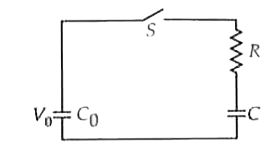A capacitor of capacitance "C" and potential "V" has energy "E" .It is connected to another capacitor of capacitance "2C" and potential "2V" .Then the loss of energy is x3E ,where "x" is_______________
To solve the problem, we need to analyze the energy stored in two capacitors before and after they are connected together. Let's follow the steps systematically.
Step 1: Calculate Initial Energies
1. Capacitor 1 has capacitance C and voltage V:
E1=12CV2
2. Capacitor 2 has capacitance 2C and voltage 2V:
E2=12(2C)(2V)2=12(2C)(4V2)=4CV2
3. Total Initial Energy:
Einitial=E1+E2=12CV2+4CV2=12CV2+82CV2=92CV2
Step 2: Charge on Each Capacitor
1. Charge on Capacitor 1:
Q1=C⋅V
2. Charge on Capacitor 2:
Q2=2C⋅(2V)=4CV
3. Total Initial Charge:
Qtotal=Q1+Q2=CV+4CV=5CV
Step 3: Final Conditions After Connection
When the two capacitors are connected together, they will share the charge, and the final voltage across both capacitors will be the same.
Let Vf be the final voltage across both capacitors.
1. Charge on Capacitor 1 after connection:
Q′1=C⋅Vf
2. Charge on Capacitor 2 after connection:
Q′2=2C⋅Vf
3. Charge Conservation:
Qtotal=Q′1+Q′2⇒5CV=CVf+2CVf
5CV=3CVf⇒Vf=53V
Step 4: Calculate Final Energies
1. Final Energy in Capacitor 1:
E′1=12C(Vf)2=12C(53V)2=12C⋅259V2=2518CV2
2. Final Energy in Capacitor 2:
E′2=12(2C)(Vf)2=12(2C)(53V)2=C⋅259V2=259CV2
3. Total Final Energy:
Efinal=E′1+E′2=2518CV2+259CV2=2518CV2+5018CV2=7518CV2=256CV2
Step 5: Calculate Loss of Energy
1. Loss of Energy:
ΔE=Einitial−Efinal=92CV2−256CV2
To perform the subtraction, convert 92 to a fraction with a denominator of 6:
92=276
ΔE=276CV2−256CV2=26CV2=13CV2
Step 6: Relate Loss of Energy to Given Expression
The loss of energy is given as x3E, where E=12CV2.
1. Substituting for E:
ΔE=13CV2=x3⋅12CV2
2. Equating:
13CV2=x6CV2
3. Solving for x:
x=2
Final Answer
Thus, the value of x is 2.
1. Capacitor 1 has capacitance C and voltage V:
E1=12CV2
E2=12(2C)(2V)2=12(2C)(4V2)=4CV2
Einitial=E1+E2=12CV2+4CV2=12CV2+82CV2=92CV2
1. Charge on Capacitor 1:
Q1=C⋅V
Q2=2C⋅(2V)=4CV
Qtotal=Q1+Q2=CV+4CV=5CV
When the two capacitors are connected together, they will share the charge, and the final voltage across both capacitors will be the same.
Q′1=C⋅Vf
Q′2=2C⋅Vf
Qtotal=Q′1+Q′2⇒5CV=CVf+2CVf
5CV=3CVf⇒Vf=53V
1. Final Energy in Capacitor 1:
E′1=12C(Vf)2=12C(53V)2=12C⋅259V2=2518CV2
E′2=12(2C)(Vf)2=12(2C)(53V)2=C⋅259V2=259CV2
Efinal=E′1+E′2=2518CV2+259CV2=2518CV2+5018CV2=7518CV2=256CV2
1. Loss of Energy:
ΔE=Einitial−Efinal=92CV2−256CV2
92=276
ΔE=276CV2−256CV2=26CV2=13CV2
The loss of energy is given as x3E, where E=12CV2.
ΔE=13CV2=x3⋅12CV2
13CV2=x6CV2
x=2
Thus, the value of x is 2.
Topper's Solved these Questions
Similar Questions
A capacitor of capacity C charged to potential "V" and " then connected to an identical uncharged capacitor then loss of energy is
View SolutionA parallel plate capacitor of capacitance C is charged to a potential V. It is then connected to another uncharged capacitor having the same capacitance. Find out the ratio of the electrostatic energy stored in the combined system to that stored initially in the single capacitor.
View Solution
Knowledge Check
The energy stored in a capacitor of capacity C and potential V is given by
A0.5C2VB0.5CV2C0.5 CVD0.5C2V2A capacitor of capacitance C0 is charged to potential V0. Now it is connected to another uncharged capacitor of capacitance C02. Calculate the heat loss in this process.
A12C0V20B13C0V20C16C0V20D18C0V20A capacitor of capacitance C0 is charged to a potential V0 and is connected with another capacitor of capacitance C as Shown . After closing the switch S, the common potential across the two capacitors becomes V . The capacitance C is given by
 AC0(V0−V)V0BC0(V−V0)V0CC0(V+V0)VDC0(V0−V)V
AC0(V0−V)V0BC0(V−V0)V0CC0(V+V0)VDC0(V0−V)V
A parallel plate capacitor of capacitance C is charged to a potential V. It is then connected to another uncharged capacitor having the same capacitance. Find out the ratio of the energy stored in the combined system to that stored initially in the single capacitor.
View SolutionA parallel plate capacitor of capacitance C is charged to a potential V. It is then connected to another uncharged capacitor having the same capacitance. Find out the ratio of the energy stored in the combined system to that stored initially in the single capacitor.
View SolutionObtain the expression for the energy stored in a parallel plate capacitor of capacitance C charged to a potential V.
View SolutionA capacitor or capacitance C1 is charge to a potential V and then connected in parallel to an uncharged capacitor of capacitance C2. The fianl potential difference across each capacitor will be
View SolutionA capacitor of capacitance 10μF charged to 100V is connected to an uncharged capacitor. The effective potential now is 40 V. The capacitance on uncharged capacitor is
View Solution
